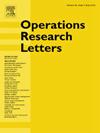通过线性规划进行稀疏图形设计
IF 0.8
4区 管理学
Q4 OPERATIONS RESEARCH & MANAGEMENT SCIENCE
引用次数: 0
摘要
图形设计是对图形上的函数进行采样和数值积分的框架。在本论文中,我们介绍了一种解决图形设计稀疏性和准确性之间权衡的方法。我们展示了如何通过线性编程和设计目标函数获得稀疏图形设计,从而最大限度地提高其准确性。我们使用纽约市的黄色出租车数据展示了我们的方法。本文章由计算机程序翻译,如有差异,请以英文原文为准。
Sparse graphical designs via linear programming
Graphical designs are a framework for sampling and numerical integration of functions on graphs. In this note, we introduce a method to address the trade-off between graphical design sparsity and accuracy. We show how to obtain sparse graphical designs via linear programming and design objective functions that aim to maximize their accuracy. We showcase our approach using yellow taxicab data from New York City.
求助全文
通过发布文献求助,成功后即可免费获取论文全文。
去求助
来源期刊

Operations Research Letters
管理科学-运筹学与管理科学
CiteScore
2.10
自引率
9.10%
发文量
111
审稿时长
83 days
期刊介绍:
Operations Research Letters is committed to the rapid review and fast publication of short articles on all aspects of operations research and analytics. Apart from a limitation to eight journal pages, quality, originality, relevance and clarity are the only criteria for selecting the papers to be published. ORL covers the broad field of optimization, stochastic models and game theory. Specific areas of interest include networks, routing, location, queueing, scheduling, inventory, reliability, and financial engineering. We wish to explore interfaces with other fields such as life sciences and health care, artificial intelligence and machine learning, energy distribution, and computational social sciences and humanities. Our traditional strength is in methodology, including theory, modelling, algorithms and computational studies. We also welcome novel applications and concise literature reviews.
 求助内容:
求助内容: 应助结果提醒方式:
应助结果提醒方式:


